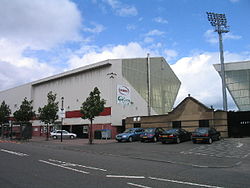
Easter Road is a football stadium located in the Leith area of Edinburgh, Scotland, which is the home ground of Scottish Premiership club Hibernian (Hibs). The stadium currently has an all-seated capacity of 20,421, which makes it the fifth-largest football stadium in Scotland. Easter Road is also known by Hibs fans as "The Holy Ground" or "The Leith San Siro". The venue has also been used to stage international matches, Scottish League Cup semi-finals and was briefly the home ground of the Edinburgh professional rugby union team.
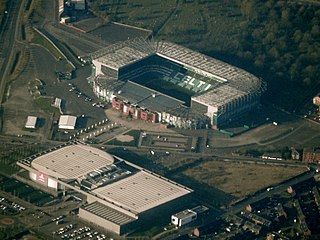
Celtic Park is a football stadium, currently the home of Scottish Premiership team Celtic Football Club, in the Parkhead area of Glasgow, Scotland. With a capacity of 60,832, it is the largest football stadium in Scotland, and the eighth-largest stadium in the United Kingdom. It is also known as Parkhead or Paradise.

Ibrox Stadium is a football stadium on the south side of the River Clyde in the Ibrox area of Glasgow, Scotland. The home of Scottish Premiership team Rangers Football Club, Ibrox is the third largest football stadium in Scotland, with an all-seated capacity of 50,817. The stadium was designed by renowned football stadium architect Archibald Leitch, with renovations to the stadium between 1978 and 1981, as well as 1990 and 1991, being designed by The Miller Partnership and Gareth Hutchison respectively.

Villa Park is a football stadium in Aston, Birmingham, with a seating capacity of 42,640. It has been the home of Premier League club Aston Villa since 1897. The ground is less than a mile from both Witton and Aston railway stations and has hosted sixteen England internationals at senior level, the first in 1899 and the most recent in 2005. Villa Park has hosted 55 FA Cup semi-finals, more than any other stadium, and it is the 10th largest in England.

Pittodrie Stadium, commonly referred to as Pittodrie, is an all-seater stadium in Aberdeen, Scotland. Used primarily for football, it has been the home ground of the Scottish Professional Football League (SPFL) club Aberdeen F.C. since they were formed in 1903. Prior to then, the ground hosted the original Aberdeen F.C. from 1899 until the merger that created the present club.

Tannadice Park, usually referred to as Tannadice, is a football stadium in Dundee, Scotland. It is the home ground of Dundee United F.C., who have played at Tannadice since the club was founded as Dundee Hibernian in 1909. The stadium has been all-seated since 1994 and has a capacity of 14,223. It is located only 200 yards from Dundee F.C.'s stadium, Dens Park; the two are the closest senior football grounds in the UK.

Dens Park, officially known as Scot Foam Stadium for sponsorship reasons, is a football stadium in Dundee, Scotland, which is the home of Scottish Premiership club Dundee F.C. and has a capacity of 11,775. Tannadice Park, the home of rivals Dundee United, is just 200 yards away.

Fir Park Stadium is a football stadium situated in Motherwell, North Lanarkshire, Scotland. The stadium plays host to the home matches of Scottish Premiership club Motherwell and was the temporary home of Gretna for the 2007–08 SPL season. Motherwell moved to the stadium in 1896, previously playing their football at Dalziel Park.
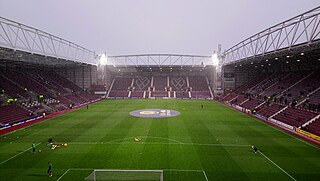
Tynecastle Park, also known as Tynecastle Stadium, is a football stadium in the Gorgie area of Edinburgh, which is the home ground of Scottish Professional Football League club Heart of Midlothian (Hearts). A UEFA category four stadium, it has also hosted Scotland international matches, and been used as a neutral venue for Scottish Cup and Scottish League Cup semi-finals.
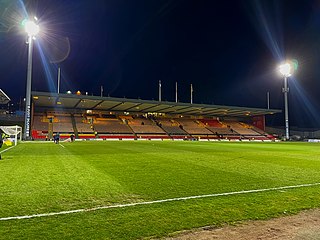
Firhill Stadium, also known as Wyre Stadium at Firhill for sponsorship reasons, is a football and former rugby union, rugby league and greyhound racing stadium located in the Maryhill area of Glasgow, Scotland which has been the home of Partick Thistle since 1909.
Brockville Park was a football stadium located on Hope Street in Falkirk, Scotland, 0.25 miles (0.4 km) north-west of the town centre. It was the home of Falkirk F.C. from 1885 until the end of 2002–03 Scottish football season. The record attendance at Brockville Park was 23,100 on 21 February 1953 in a match against Celtic. The stadium has since been replaced with a Morrisons supermarket. An old turnstile is on display next to the supermarket's car park.

Victoria Park, also known as the Global Energy Stadium for sponsorship reasons, is an all-seater football stadium in the town of Dingwall, Highland, Scotland. It is the home ground of Ross County, who currently play in the Scottish Premiership.
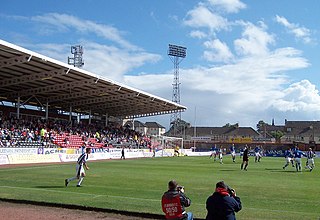
St Mirren Park, more commonly known as Love Street, was a football stadium located on Love Street in Paisley, Scotland. At one time the stadium was capable of accommodating almost 50,000 spectators, however in its final years it had an all-seated capacity of 10,800. Until its closure in 2009, it was the home ground of St Mirren F.C.
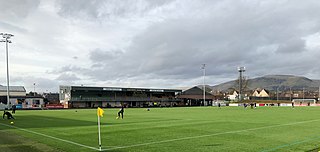
Recreation Park, also known as Recreation Grounds, The Recs and The Indodrill Stadium for sponsorship reasons, is a football stadium in Alloa, Clackmannanshire, Scotland. It is the home ground of Scottish Professional Football League team Alloa Athletic, who have played there since 1895. Additionally, Broomhill of the Scottish Lowland Football League have been groundsharing at Recreation Park since 2016. Central Girls Football Academy have used the stadium for home matches from 2017. The stadium has an artificial playing surface and has a capacity of 3,100.

Firs Park was a football stadium in Falkirk, Scotland, which was the home of East Stirlingshire F.C. between 1921 and 2008. It was located on Firs Street, 0.3 miles north-east of the town centre. At the time of closing the ground had a capacity of 1,800 with 200 seated.
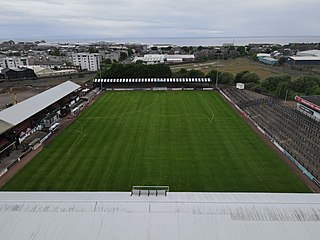
Somerset Park is a football stadium located in Ayr, South Ayrshire, Scotland. It has been the home of Scottish Championship team Ayr United since the club was founded in 1910. Prior to that, it was the home ground of Ayr, who merged with Ayr Parkhouse to form Ayr United. The 10,185 capacity stadium was designed by renowned football stadium architect Archibald Leitch.

Cliftonhill Stadium, commonly known as Cliftonhill and currently 'The Reigart Stadium' for sponsorship purposes, is a football stadium in Coatbridge, North Lanarkshire, Scotland. It is the home ground of former Scottish Professional Football League team Albion Rovers F.C., who have played at the ground since 1919.

Central Park is a multi-use stadium in Cowdenbeath, Fife, Scotland, used for football and stock car racing. It is situated in the centre of the town, just off the High Street, and has a capacity of 4,309. The pitch size is 107 x 66 yards. Central Park has been the home ground of Lowland League team Cowdenbeath F.C. since it opened in 1917. Stock car racing has taken place at the ground since 1970, and takes place on a tarmac racetrack surrounding the football pitch. Central Park was also previously a venue for greyhound racing between 1928 and 1965.

Links Park is a football stadium in Montrose, Scotland. It has been the home ground of Montrose F.C. since 1887.
Boghead Park was a football ground in the town of Dumbarton, Scotland. It was owned by Dumbarton F.C., who played there for 121 years between 1879 and 2000. By the time the ground closed in 2000, it was the oldest stadium in Scotland that had been in continuous use.
